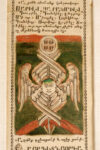PRAYER ROLL
Printed, early 18th c. Constantinople. Fragment
PRAYER ROLL
Printed, early 18th c. Constantinople. Fragment
Condition: three pieces stuck together; woodcut enhanced with red, green, purple colors.
The fragment contains prayers calling for the protection of angels, against the evil eye, against the evil tongue, for travelers, against the evil eye, followed by a blessing of the prophets and the sacrifice of Abraham. As on the hand-written phylacteries, the Genesis passage forms decorative lozenges with a crucial element in their center. The two images engraved on this fragment are very common. A seraph carries a labarum with the inscription “”thrice holy””. The sacrifice illustrates the moment when the angel stops the gesture of Abraham ready to immolate his son, his hands tied in front of a vessel where incense is burning. Although standardized, the iconography here attributes greater freedom to the gestures of the characters, which are distantly derived from Western engraving. Two other fragments preserved in the Fringhian Museum seem to come from the same scroll produced, for the needs of printing, in several joined pieces. The content and illustration of the printed phylacteries do not seem to vary much from those of the handwritten scrolls. Two scrolls in a private collection in Nice are 4m long and were obtained from the same wood as the one in the museum. Colophons, one of which bears the date 1709, situate their production in Constantinople, where this fragment probably originated, as do a large number of handwritten amulets.
Provenance : former Nourhan Fringhian collection.
Bibliography: Fringhian Museum catalog, 1989.
Paris, Armenian Museum of France, Nourhan Fringhian Foundation.
Ioanna Rapti
cf. Armenia Sacra, p. 32, Editions Somogy/Musée du Louvre 2007.
In Armenia, the art of books is linked to the invention of writing. Until the 5th century AD, the inhabitants of the Armenian plateau had successively used the cuneiform script (Urartu), and later, with the various conquests, Aramaic (the Persian period), Greek (the Hellenistic and Parthian period) and Latin characters (under Roman domination).
Driven by the need to have a specific writing adapted to the language, around the year 405, an Armenian monk, Mesrop Mashtots, invented an alphabet composed of thirty-six letters or graphemes corresponding to the thirty-six phonemes of the oral language used in the 5th century.
The most widely distributed and recognized book in this Christian nation was the first to be transcribed: The Bible.
This allowed the many copyists in monasteries to learn the alphabet, and they acted as network for disseminating Christianity, and thereby strengthening Armenian identity. This transmission of a culture and a religion made it possible for the identity of a civilisation remain intact despite the vicissitudes of history.
The texts were at first, for the most part, religious, biblical (The Bible—Gospels) or liturgical (Lectionaries—Hymnaries—Psalms—Homiliaries, etc.).
From the end of the 9th century, there was an increase in the amount of manuscript works produced, propagating the faith of a people through this fundamental medium which is writing: it is the union of the written word and religion that allowed this people to survive, despite the lack of an organised state.
To embellish the written word, painters assisted the scribes, and it is in books that we find the best expression of Armenian pictorial art.
The Armenian book was printed in 1511, but manuscripts had such a predominant role that, unlike other countries, book printing in Armenia did not fully develop until the 18th century and it was not until the 19th century that it reached the stage where it could actually replace the work performed by hand.



